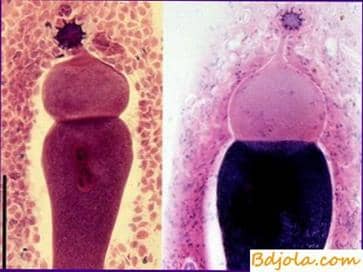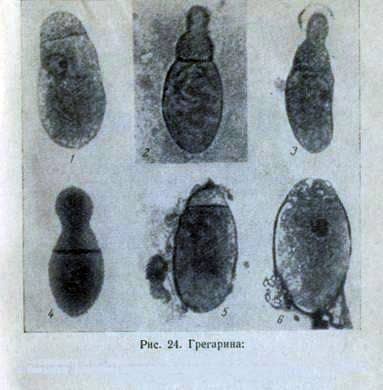Gregarinosis of bees

Gegarinosis is an invasive disease of bee colonies, which causes an intestinal disorder. The disease is poorly understood.
The causative agent of the disease is the Greek animal – the protozoa (Protozoa), from the class of sporoviks, the subclass Telesporidia, the body is divided into 2 or 3 parts.
Parasitizing bees of Greek sperm from the genus Leidyana Watson has an oval or almost cylindrical shape, the maximum dimensions of the parasite in the sporot stage are 164 x 94 microns in length and 40-60 microns in width.

1 – sporont; 2 – cephalate; 3 – cephalate with epimerite; 4 – cephalate with a large dense epithelium; 5 – cephalate (bottom left) and back;
6 – sporot and spores of nosema (lower left).
The body of the gregarina is covered externally with a thin cuticle and is divided by a transverse septum into two unequal parts: anterior smaller, called protomerate, and a larger posterior, called deutomerate. The protometite is hemispherical, sometimes almost conic. Protoplasm is divided into two layers: outer, lighter, homogeneous and internal, darker, granular. The nucleus is in the deuteromer. The nucleus is well expressed eccentrically located nucleolus.
At the protometer at the front end there can be a rounded smooth convexity – an epimerite, which is an attachment device – a sucker. With the help of the epimerite, young forms of gregarine attach to the epithelial wall of the mid-colon of the bee (the site of its localization) and feed on juices.
Young gregorins of the dividing septum between the epimerite and the protometite are not present, but these parts can differ in density of color. Gregarins in the stage that has an epimerite are called cephalonts, and the next stage, when epimerite is absent, is called sporon. The subsequent stages, such as cyst formation and sporulation, were not detected. Therefore, the exact definition of the species of gregarina is difficult. It is possible that the cyst formation occurs in the contents of the hindgut or in the stool of the bees.
Epizootic data. The causative agent of the disease is contained in the bees and parasites of the bee family. From parasites of bee colonies, gregarina is found in various species of moth (small wax, flour), beehive beetles. They pollute honeycombs, honey and drinkers with excrement. Infection occurs when ingestion of spores by a bee.
The diagnosis is based on the examination of smears under a microscope with low and medium magnifications. Gregarins are usually found when researching the intestines of bees on nosematosis and amebiasis.
Prevention and control measures. As with nosematosis.
Gregarinosis of bees
